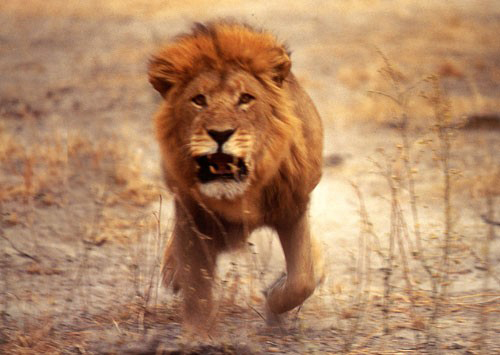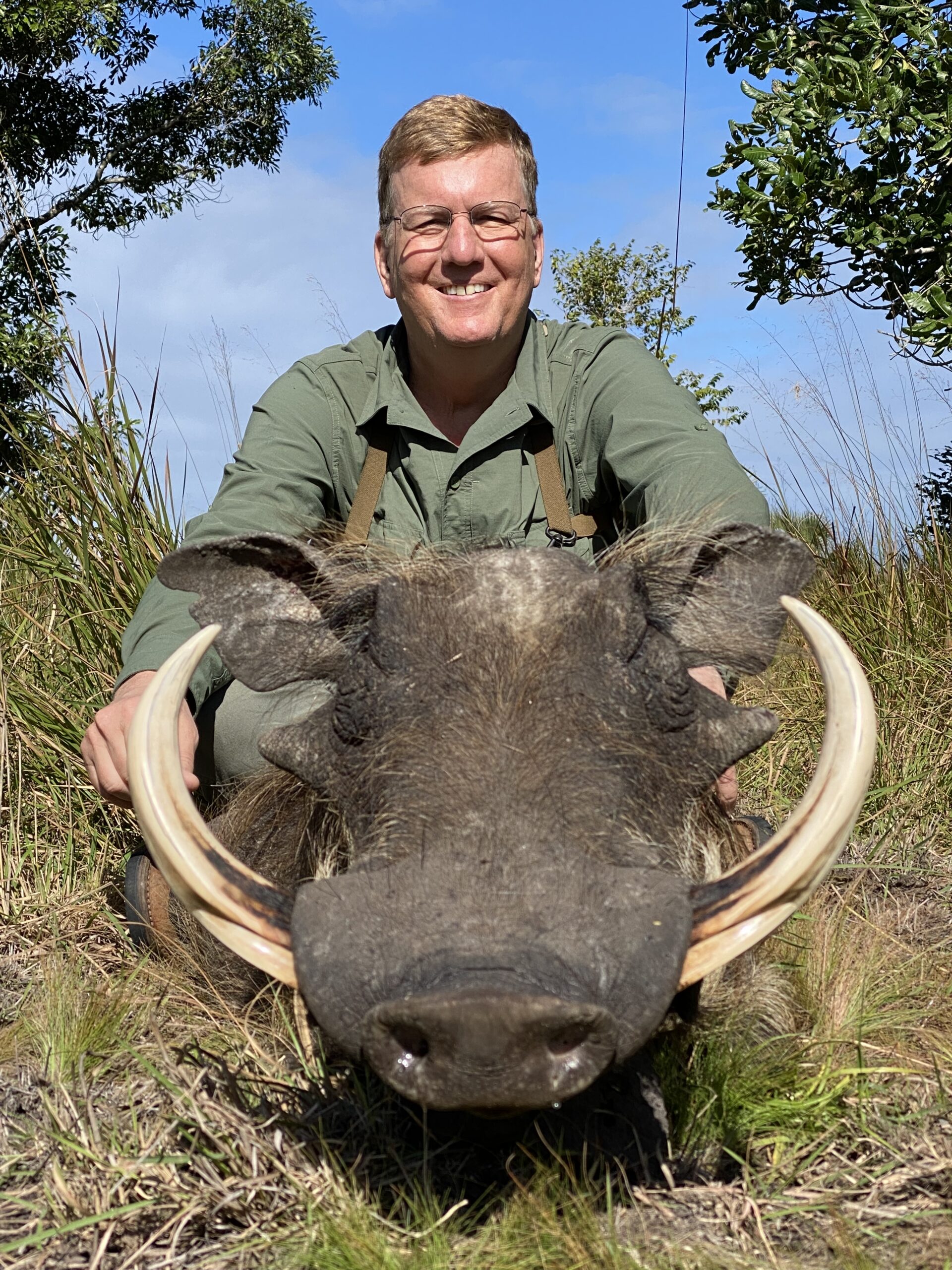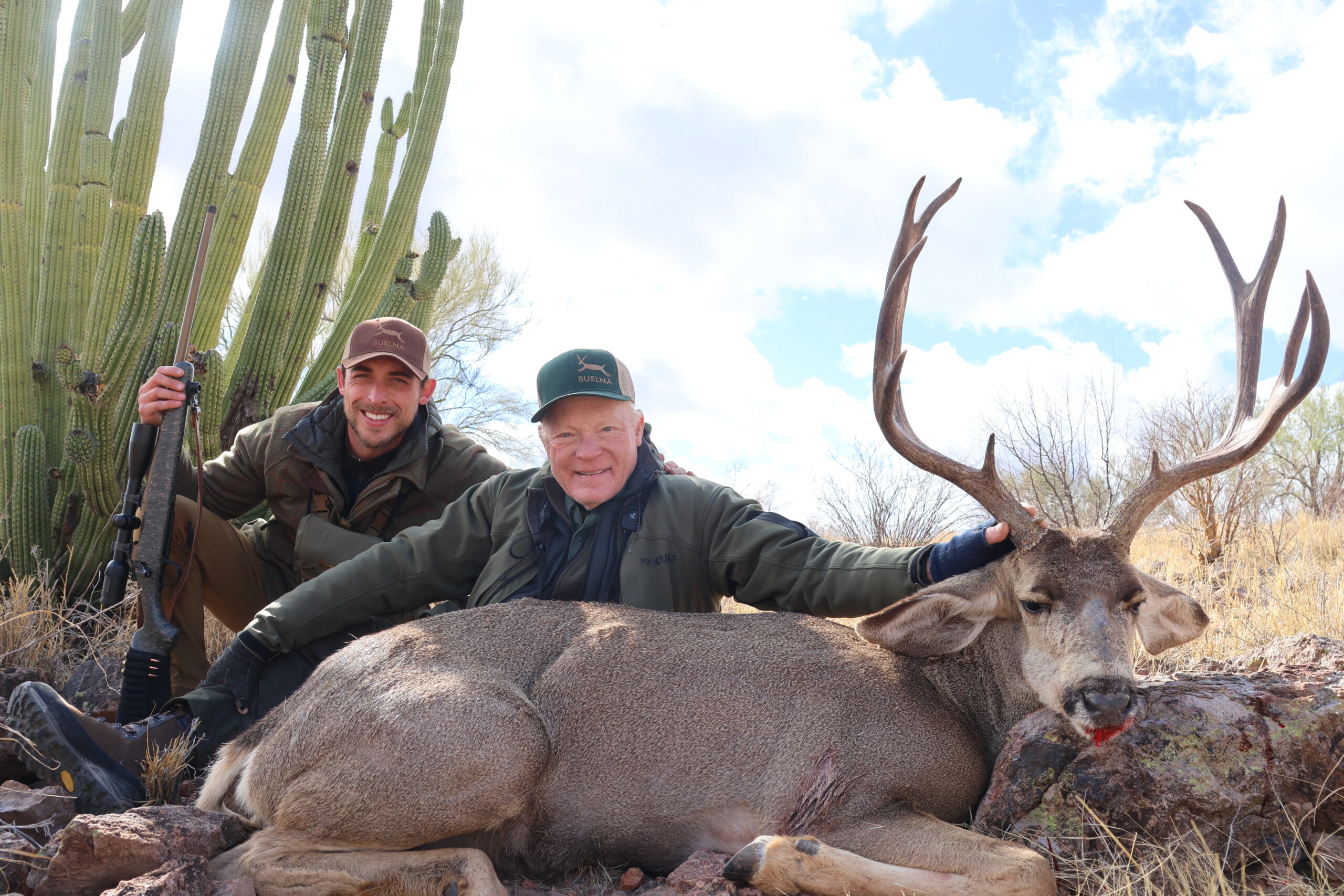In 1910-11 Stewart Edward White and R. J. Cunninghame, who guided Theodore Roosevelt, undertook an expedition to explore the areas around the Anglo-German boundary because so little was known about them. This was considered the very last virgin game field of any great size remaining to be discovered and opened up to sportsmen. It was the final “odd corner” to be looked into. Why? Because from the German side, this area was much too far away; and from the British side it was practically inaccessible. Thus, most of the animals had never been hunted. Their encounters with lions provided many interesting stories.—EEH
Every book on African hunting and every African hunter worthy of the name, will tell you that a lion will never, in daylight, attack a man unprovoked. There is no blither warrior that the lion when he is given due cause to fight. You can stop or turn a charging elephant, a charging buffalo, or a charging rhinoceros by pounding him hard enough; but not a charging lion. If once he starts for you, you must kill him. Furthermore, a comparatively light annoyance will sometimes cause him to charge. You don’t need to wound him. But unprovoked and out of hunting hours, he is supposed to be a peaceful citizen. Today, I had one experience that apparently was an exception.

I struck out to the southeast, merely because from the top of the kopje, beside the big distant rocks, we had seen some similar outcrops striking up above the bush only four or five miles away. From the top of the kopje, they looked nearer. When we came to walk the distance, we found it considerably more than we had anticipated. Down the long gentle slope of the hills, across the valley, up the long gentle slope on the other side and so repeat. In each valley and on every slope, we found game. In one little burned patch, a steenbok lay crouched down close, its ears folded back just like those of a dog that considers himself especially virtuous. In the grass the little antelope would have been perfectly concealed. Evidently it considered the fact that the grass had been burned as an extraneous detail for he held his position as rigidly as though he had been completely hidden. As a matter of fact, it was in plain sight.
We reached and examined the rocky outcrop. Then quite idly we turned down the valley in which we stood. Along the center of the valley ran a shallow dry watercourse in the bottom of which grew various sorts of brush. This brush strip varied in width from nothing to 100 feet. Memba Sasa and I took one side of it, while Sanguiki and two carriers took the other. We had no idea of what to expect.
It is great fun to quietly follow one of these brushy little ravines. You never know what will peep out next. It is no good to raise a row and yell and throw stones. If you do that, everything sets out far ahead. But if you just sneak quietly along, perhaps occasionally tossing a pebble into the likely looking thick places, you will have lots of fun. There are always clouds of little birds. Near water pools they are incredibly numerous, so that the aggregate of their tiny weights bends down quite good-sized saplings. There are also many larger birds, as well as monkeys that gallop away ahead and baboons that bark.
And of other animals there is no end. A dik-dik, an oribi, a steenbok, a bushbuck – is always scrambling madly away from almost beneath one’s feet into another bit of cover where it hopes for better luck at remaining concealed. Occasionally some mighty crash brings one up all standing, every muscle taut, every sense alert. Then, if all is silent, comes maneuvering, cautious reconnoitering, a scouting for a sight either of the beast or his tracks. Or, if the crashes continue, there is a scurrying to and fro for a point of vantage and reasonable safety. Probably it is an old rhinoceros disturbed at his nap, or a stray buffalo. If you are hunting neither of these creatures, and we are not, your whole desire is to avoid an encounter. To do this, however, means no unwise policy of concealment. It is well to see the beast as soon as possible in order to know how to pay due respect to his choice of routes.
One practical word of advice: when engaged in this harmless and pleasing pastime, do not carry your lightest gun in your hand. If anything unexpected happens, it is well to have your heaviest armament where it is handiest. For that reason, I was carrying the .405.

We wandered down along this valley for two or three miles and were just beginning to think the sun hot, when we came to a slight widening of the brush patches. Sanguiki and his men were out of sight across the ravine. Memba Sasa had angled 15 or 20 feet to the left with the purpose of looking down a hole. Suddenly I heard to my right, a tearing scramble and crashing of small brush.
So vigorous was this crashing that I thought it must be either a buffalo or a rhinoceros. The banks of the ravine immediately at hand were almost perpendicular and perhaps eight or 10 feet high. Both upstream and downstream, and 20 yards apart, game trails had been worn to a good grade. I ran to a point midway between these game trails. My thought was, that from this vantage I would be able to see the beast whether it continued in the bed of the ravine or whether it climbed out by either of the trails. This looked like a safe plan, for no rhinoceros or buffalo would attempt to scale that steep bank.
A big maned lion leaped to the top of the bank right in my face!
I was just four yards from him. In the fraction of an instant that he paused to assure his balance I recovered from the shock of surprise, swung the bead of my .405 on him and pulled the trigger. It would be exceedingly interesting to know just the actual lapse of time between the appearance of the lion, and the first shot. In reality it must have been exceedingly short, for the beast was caught between the landing from his leap and his spring. He undoubtedly intended to attack, and he knew just where we were and was out to make a fight of it. Yet, I apparently had time to notice a great many details, such as the fact that the lion had an unusually fine mane, that the mane was so erect between the ears as to almost point forward, and that his eyes looked round rather than elliptical.
Later Memba Sasa told me that he wondered whether I would ever shoot. Nevertheless, before the lion had even tensed his muscles for the next effort that would land him on me, the first bullet took him. It was a very interesting example of how rapidly and comprehensively the human mind works under excitement.
The .405 Winchester delivers a blow of about 3,300 foot-pounds and this lion was so near that the velocity was in no way diminished by air resistance. The largest buffalo I ever saw was knocked right off his feet by a shoulder shot from it. The lion did not lose his balance, but the force of the blow thrust him sidewise as a paper box is blown by a violent gust of wind. That he was not knocked flat seems to me remarkable. Perhaps the highly organized nervous system of the cat responded instantaneously so that the muscles reacted unconsciously and at once. I yanked the lever of my own rifle down and back and put in another. The bullet entered just two inches from the first. I was shooting for the heart, as the head shot on a lion is always uncertain.

The second shot again thrust him so far back that he toppled over the edge of the bank and down into the ravine. I ran to the edge. He had recovered himself and was again scrambling up the steep side, growling horribly. My third shot broke his foreleg. Steadying, I raked him from end to end. He rolled over on his side still growling and roaring, biting the ground. I watched him closely for further trouble but after a moment, he died. Memba Sasa was standing close to my left elbow, the Springfield cocked, five .405 cartridges spread fanwise in his left hand.
There succeeded the brief dead pause that always seems to follow a lion row. Then we shouted. The cry was instantly answered by Sanguiki and his men. They had probably been standing with bated breath, awaiting the first definite indication of how the fight was going. Certainly there must have been enough to listen to, what with the repeated detonations of the heavy gun and snarls and growls of the lion.
We tried to carry the dead lion into the shade but were unable to lift him. Therefore we constructed a shelter of boughs. A lion’s skin is a tricky affair and must be handled immediately and carefully. He was a magnificent creature with a thick, long black and tawny mane, better than any other wild lion I ever saw, and almost equal to a menagerie beast. I never expected to get anything so good. He stood three feet, seven-inches at the shoulder, Nine feet, three-inches straight length measurement. He was a very heavy beast and must have been well up between 500 and 700 pounds.
The Memba Sasa and I began to figure over the incident. A wounded lion, or cornered lion, or even a lion that has been followed until he has become annoyed, will attack practically every time. But what had induced this old fool to pop out at us so savagely? We were walking along tending to our own business which had nothing to do with him. In my African experiences, I have, up to now, seen 103 wild lions and Memba Sasa had of course seen many more. And this was the first instance of its kind for either of us. So interested did we get, that we determined to backtrack the lion.

The trail led us immediately into a dense, low, shady thicket. Bending half over, we crawled cautiously in. A low snarl and the half-gassed yellow of a gliding body warned us that the bower — for it was a bower, a shady, pleasant, cool little arching bower — was already occupied. Crouching low, I peered as hard as I could, but did not succeed in getting another sight of the beast. We crawled in a little farther.
A dead zebra lay on its belly, all four legs stretched back. Evidently it had been dragged bodily by the head or neck. Think of the strength required for this feat! We examined it. Except for the marks of its killing, its skin was unbroken. A wide swath through the bush led us out of the thicket and fully 150 yards into the open. There the kill had been made.
Memba Sasa said, “He did not attack without good reason. He had good reason. We spoiled his party. He had his meat and his woman, and he did not intend to be disturbed.” So, after all, even this was not a case of a lion attacking entirely unprovoked. We left the carcass of the zebra as bait for the lioness. Near home, just before we dipped to cross the stream to camp, Memba Sasa let out a particular sort of howl. Before we had gone another 200 feet every man in camp was there, most of them with their faced whitened, wildly dancing the lion dance.
We spent the afternoon caring for the trophy, paring it down, doping it with alum water and finally stretching it in a huge frame which was hoisted into a tree. One of the Swahili porters was bragging that he liked any kind of meat, lion included. But I knew him to be a Mohammedan.–Selected and Edited by Ellen Enzler Herring of Trophy Room Books




